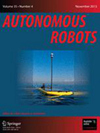The primary goal of Autonomous Robots is to report on the theory and applications of robotic systems capable of some degree of self-sufficiency. Thus the journal is aimed at the growing trend in robotics toward mobility intelligence and autonomy in an unstructured world. This trend has been made possible by small inexpensive high-performance computers. The term 'robot' implies that the systems described here are capable of performing purposeful behaviors in the real world. They obtain inputs from the world through sensors and act upon the world through actuators. The connection between sensing and actuation may be simple signal processing or it may involve complex decision making goal interpretation and other aspects of reasoning. Most autonomous systems display some form of mobility: on land under water in the air or in space. The mobility may make use of wheels legs fins rotors or other actuators. The focus is on the ability to move and be self-sufficient not on whether the system is an imitation of biology. Of course biological models for robotic systems are of major interest to the journal since living systems are prototypes for autonomous behavior. Autonomous robots must be able to perform in the world. Hence publication preference will be given to papers which include performance data on actual robots in the real world. Papers which include only simulation results will be considered for publication but with a lower priority. Such papers should also include a section entitled 'The path to implementation' where the transition from simulation to real world is discussed. Papers published in these pages will report on original research in such areas as: Control of autonomous robots Real-time vision Autonomous wheeled and tracked vehicles Legged vehicles Computational architectures for autonomous systems Distributed architectures for learning control and adaptation Studies of autonomous robot systems Sensor fusion Theory of autonomous systems Terrain mapping and recognition Self-calibration and self-repair for robots Self-reproducing intelligent structures Genetic algorithms as models for robot development.
